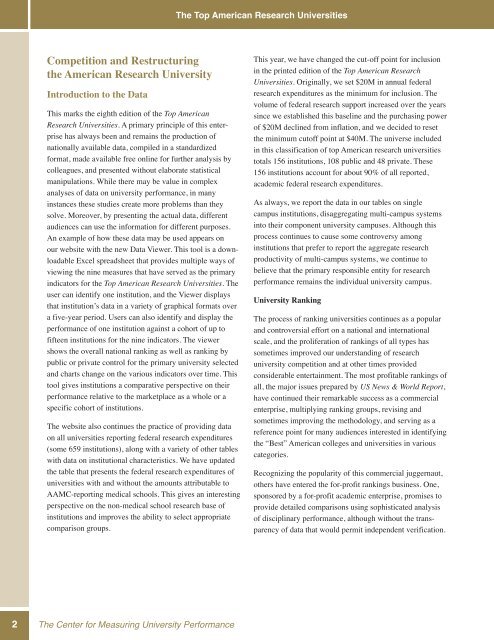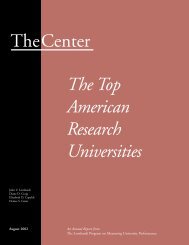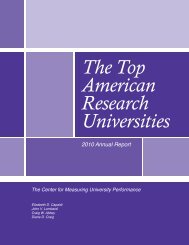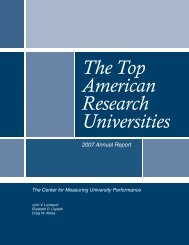The Top American Research Universities - The Center for ...
The Top American Research Universities - The Center for ...
The Top American Research Universities - The Center for ...
You also want an ePaper? Increase the reach of your titles
YUMPU automatically turns print PDFs into web optimized ePapers that Google loves.
2<br />
Competition and Restructuring<br />
the <strong>American</strong> <strong>Research</strong> University<br />
Introduction to the Data<br />
This marks the eighth edition of the <strong>Top</strong> <strong>American</strong><br />
<strong>Research</strong> <strong>Universities</strong>. A primary principle of this enterprise<br />
has always been and remains the production of<br />
nationally available data, compiled in a standardized<br />
<strong>for</strong>mat, made available free online <strong>for</strong> further analysis by<br />
colleagues, and presented without elaborate statistical<br />
manipulations. While there may be value in complex<br />
analyses of data on university per<strong>for</strong>mance, in many<br />
instances these studies create more problems than they<br />
solve. Moreover, by presenting the actual data, different<br />
audiences can use the in<strong>for</strong>mation <strong>for</strong> different purposes.<br />
An example of how these data may be used appears on<br />
our website with the new Data Viewer. This tool is a downloadable<br />
Excel spreadsheet that provides multiple ways of<br />
viewing the nine measures that have served as the primary<br />
indicators <strong>for</strong> the <strong>Top</strong> <strong>American</strong> <strong>Research</strong> <strong>Universities</strong>. <strong>The</strong><br />
user can identify one institution, and the Viewer displays<br />
that institution’s data in a variety of graphical <strong>for</strong>mats over<br />
a five-year period. Users can also identify and display the<br />
per<strong>for</strong>mance of one institution against a cohort of up to<br />
fifteen institutions <strong>for</strong> the nine indicators. <strong>The</strong> viewer<br />
shows the overall national ranking as well as ranking by<br />
public or private control <strong>for</strong> the primary university selected<br />
and charts change on the various indicators over time. This<br />
tool gives institutions a comparative perspective on their<br />
per<strong>for</strong>mance relative to the marketplace as a whole or a<br />
specific cohort of institutions.<br />
<strong>The</strong> website also continues the practice of providing data<br />
on all universities reporting federal research expenditures<br />
(some 659 institutions), along with a variety of other tables<br />
with data on institutional characteristics. We have updated<br />
the table that presents the federal research expenditures of<br />
universities with and without the amounts attributable to<br />
AAMC-reporting medical schools. This gives an interesting<br />
perspective on the non-medical school research base of<br />
institutions and improves the ability to select appropriate<br />
comparison groups.<br />
<strong>The</strong> <strong>Center</strong> <strong>for</strong> Measuring University Per<strong>for</strong>mance<br />
<strong>The</strong> <strong>Top</strong> <strong>American</strong> <strong>Research</strong> <strong>Universities</strong><br />
This year, we have changed the cut-off point <strong>for</strong> inclusion<br />
in the printed edition of the <strong>Top</strong> <strong>American</strong> <strong>Research</strong><br />
<strong>Universities</strong>. Originally, we set $20M in annual federal<br />
research expenditures as the minimum <strong>for</strong> inclusion. <strong>The</strong><br />
volume of federal research support increased over the years<br />
since we established this baseline and the purchasing power<br />
of $20M declined from inflation, and we decided to reset<br />
the minimum cutoff point at $40M. <strong>The</strong> universe included<br />
in this classification of top <strong>American</strong> research universities<br />
totals 156 institutions, 108 public and 48 private. <strong>The</strong>se<br />
156 institutions account <strong>for</strong> about 90% of all reported,<br />
academic federal research expenditures.<br />
As always, we report the data in our tables on single<br />
campus institutions, disaggregating multi-campus systems<br />
into their component university campuses. Although this<br />
process continues to cause some controversy among<br />
institutions that prefer to report the aggregate research<br />
productivity of multi-campus systems, we continue to<br />
believe that the primary responsible entity <strong>for</strong> research<br />
per<strong>for</strong>mance remains the individual university campus.<br />
University Ranking<br />
<strong>The</strong> process of ranking universities continues as a popular<br />
and controversial ef<strong>for</strong>t on a national and international<br />
scale, and the proliferation of rankings of all types has<br />
sometimes improved our understanding of research<br />
university competition and at other times provided<br />
considerable entertainment. <strong>The</strong> most profitable rankings of<br />
all, the major issues prepared by US News & World Report,<br />
have continued their remarkable success as a commercial<br />
enterprise, multiplying ranking groups, revising and<br />
sometimes improving the methodology, and serving as a<br />
reference point <strong>for</strong> many audiences interested in identifying<br />
the “Best” <strong>American</strong> colleges and universities in various<br />
categories.<br />
Recognizing the popularity of this commercial juggernaut,<br />
others have entered the <strong>for</strong>-profit rankings business. One,<br />
sponsored by a <strong>for</strong>-profit academic enterprise, promises to<br />
provide detailed comparisons using sophisticated analysis<br />
of disciplinary per<strong>for</strong>mance, although without the transparency<br />
of data that would permit independent verification.<br />
1 Other rankings identify institutions by philosophical approach such as the Mother Jones <strong>Top</strong> 10 Activist Campuses, the John Templeton Foundation:<br />
Colleges That Encourage Character Development, the Young America's Foundation <strong>Top</strong> Ten Conservative Colleges, or A New Ranking of <strong>American</strong><br />
Colleges on Laissez-Faire Principles, 1999-2000. Still others present rankings based on the opinions of student constituencies such as<br />
StudentsReview.com and Princeton Review's <strong>The</strong> Best Colleges Ranked by Students.








